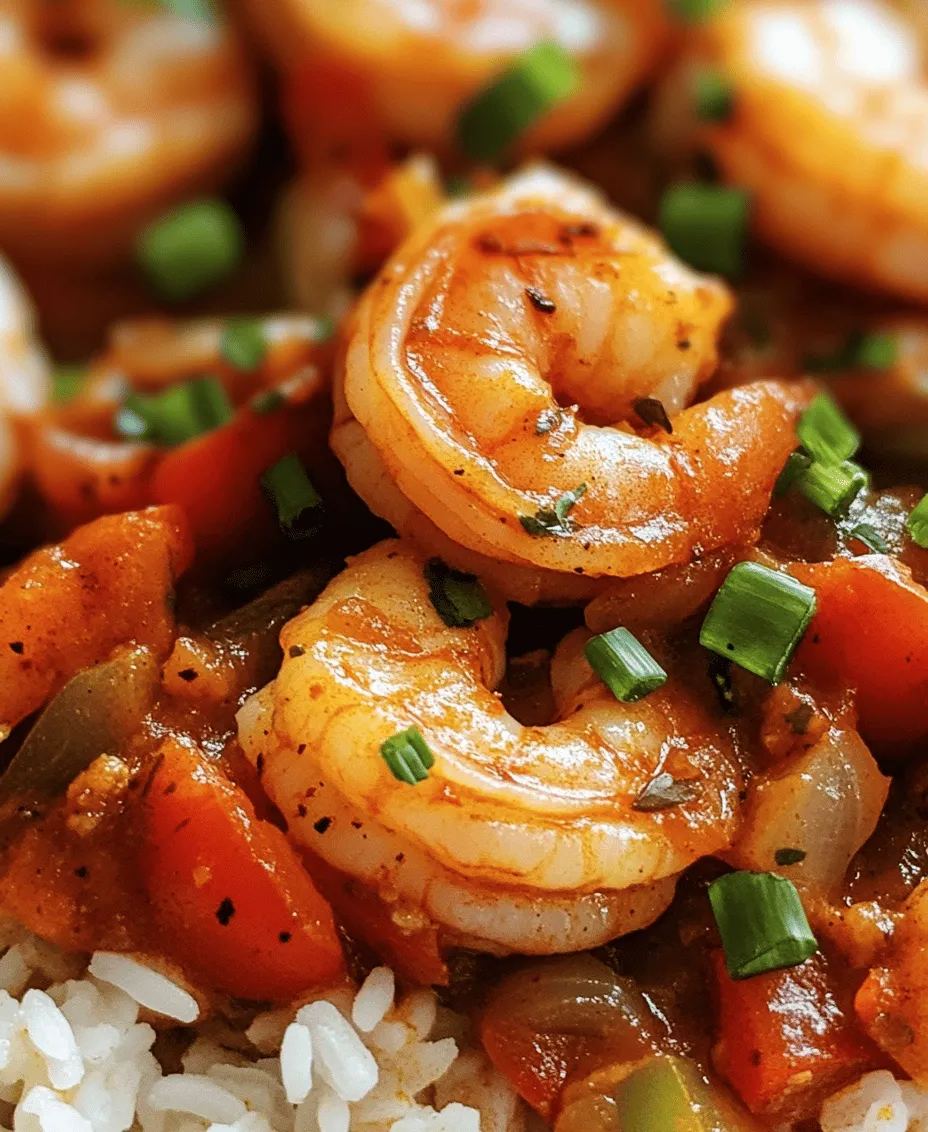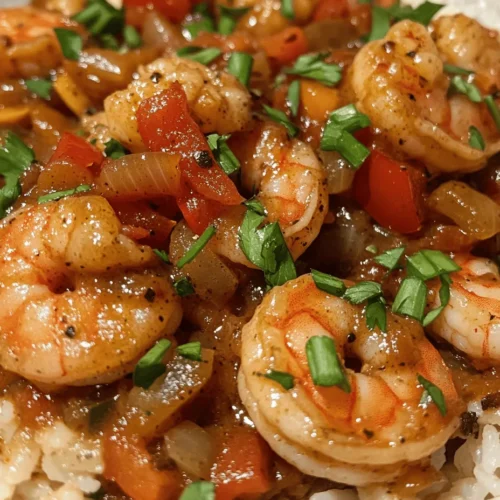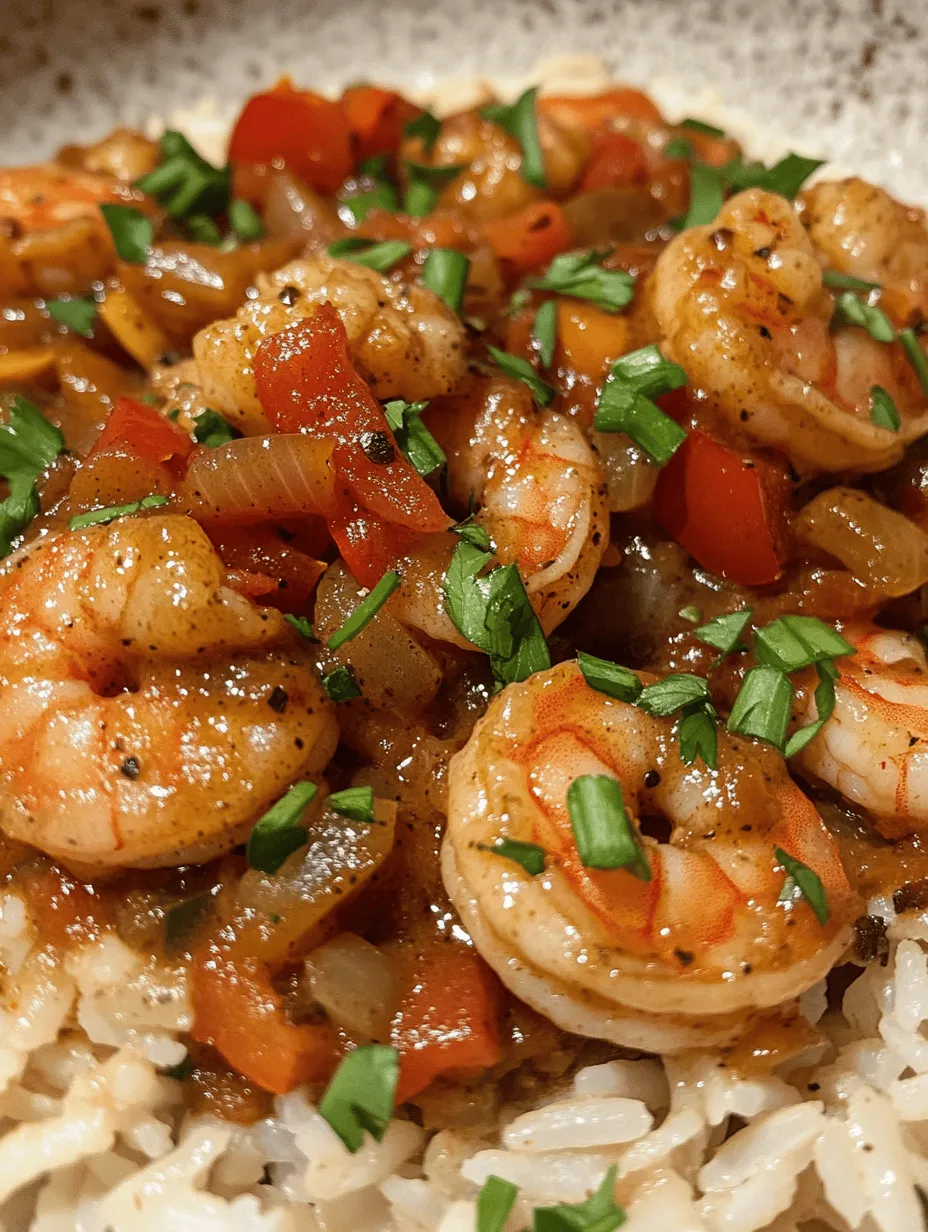Introduction to Shrimp Etouffee: A Flavorful Cajun Classic
Shrimp Etouffee is a dish that embodies the heart and soul of Cajun cuisine, bringing together rich flavors and a deep cultural heritage that has been passed down through generations. Originating in the bayous of Louisiana, Etouffee—meaning “to smother” in French—refers to the method of slow-cooking shrimp in a flavorful sauce, typically served over a bed of rice. This classic dish has become a staple in both home kitchens and restaurants, celebrated for its comforting, hearty taste and its ability to transport diners to the vibrant landscapes of Louisiana.
The cultural significance of Shrimp Etouffee cannot be overstated. This dish is a testament to the melting pot of cultures that defines Louisiana, blending French, Spanish, African, and Native American influences. It is often associated with festive gatherings, family celebrations, and the famous Mardi Gras season, where the joy of cooking and sharing food brings people together. The rich history and communal aspects of Shrimp Etouffee make it more than just a meal; it is an experience steeped in tradition and camaraderie.
When it comes to flavor, Shrimp Etouffee is a delightful medley of spices and textures. The dish boasts a robust, savory profile, thanks to its base of the “holy trinity” of Cajun cooking: onions, bell peppers, and celery. The shrimp, cooked to tender perfection, absorb the rich flavors of the sauce, while the roux—a thickener made of butter and flour—adds a nutty depth that elevates the dish. A sprinkle of Cajun seasoning and the aromatic notes of bay leaves further enhance its complexity, making each bite a celebration of Southern cuisine.
In a fun twist on this traditional recipe, we introduce the “Coloring Book Extravaganza” concept—a playful approach that invites cooks of all ages to engage with the process of making Shrimp Etouffee in a creative way. Just as coloring books allow for personal expression and artistic flair, this recipe encourages you to put your own spin on a beloved classic. Whether it’s experimenting with different vegetables, adjusting the spice levels, or even presenting the dish in a colorful way, the Coloring Book Extravaganza offers a delightful opportunity to explore and enjoy Cajun cooking.
Understanding the Ingredients: Key Components of Shrimp Etouffee
The Star Ingredient: Shrimp
At the heart of Shrimp Etouffee lies the shrimp itself. This seafood delicacy is not only delicious but also packed with nutritional benefits. Rich in protein and low in calories, shrimp is a fantastic source of essential nutrients such as vitamin B12, selenium, and omega-3 fatty acids. These nutrients contribute to heart health, brain function, and overall well-being.
When preparing Shrimp Etouffee, it’s crucial to use fresh, high-quality shrimp for the best flavor and texture. Whether you choose large, juicy Gulf shrimp or smaller varieties, ensure that they are sourced sustainably and are free from additives. Fresh shrimp should have a mild, ocean-like smell and a firm texture. If you’re using frozen shrimp, opt for those that are flash-frozen to preserve their freshness.
The Role of the Roux: Butter and Flour
The roux is a fundamental component of Shrimp Etouffee, acting as the base that brings the dish together. Made from equal parts butter and flour, the roux serves as a thickening agent and imparts a rich, velvety texture to the sauce. The process of making roux requires patience and attention, as the key to achieving the perfect consistency and color lies in cooking it slowly over low to medium heat.
To create a successful roux, melt the butter in a heavy-bottomed pot, then gradually whisk in the flour. Continue stirring constantly to prevent burning, allowing the mixture to cook until it reaches a deep golden brown color. This is where the flavor develops—a well-cooked roux will have a nutty aroma, adding depth to the overall dish. Be cautious; if the roux becomes too dark or scorched, it can impart a bitter taste, so keep a close eye on it throughout the cooking process.
The Holy Trinity of Cajun Cooking
In addition to the roux, the “holy trinity” of Cajun cooking—onions, bell peppers, and celery—is essential for building the flavor profile of Shrimp Etouffee. Each vegetable contributes its unique characteristics:
– Onions: Providing sweetness and depth, onions form the aromatic base of the dish. When sautéed with the roux, they soften and caramelize, enhancing the overall flavor.
– Bell Peppers: These colorful additions bring a slight crunch and a mild sweetness to the dish. Green bell peppers are traditional, but you can experiment with yellow, red, or orange varieties for a twist on the classic.
– Celery: Often overlooked, celery adds a subtle earthiness and crunch that balances the dish. Its fresh flavor complements the sweetness of the onions and bell peppers, creating a harmonious blend.
Importance of Seasoning
Seasoning is a critical aspect of any dish, and Shrimp Etouffee is no exception. A well-seasoned dish can transform a simple meal into a culinary masterpiece. Cajun seasoning, a blend of spices that typically includes paprika, cayenne pepper, garlic powder, and thyme, is the cornerstone of flavor in this recipe. This seasoning not only adds heat but also contributes layers of complexity that enhance the overall taste.
In addition to Cajun seasoning, bay leaves play a significant role in enriching the flavor of Shrimp Etouffee. As the dish simmers, the bay leaves release their aromatic oils, infusing the sauce with a subtle herbal essence that rounds out the flavors beautifully.
Broth and Tomatoes: Creating a Rich Base
To create a rich, flavorful base for the Shrimp Etouffee, chicken broth is a key ingredient. The broth adds depth and moisture, allowing the flavors to meld together as they cook. For the best results, use homemade chicken broth when possible, as it delivers a fresher taste compared to store-bought varieties. If you’re short on time, however, a high-quality store-bought broth can suffice.
Diced tomatoes are another important addition, providing acidity and depth that balances the richness of the roux and the sweetness of the vegetables. The tomatoes not only enhance the flavor but also contribute a beautiful color to the dish. Whether you choose canned or fresh tomatoes, ensure that they are of good quality for optimal results.
Step-by-Step Guide to Making Shrimp Etouffee
Preparation: Getting Ready to Cook
Before diving into the cooking process, preparation is key to ensuring a smooth and enjoyable cooking experience. Start by gathering all the essential kitchen tools and equipment you will need:
– A heavy-bottomed pot or Dutch oven for making the roux and simmering the sauce
– A wooden spoon or whisk for stirring
– A sharp knife and cutting board for chopping vegetables
– Measuring cups and spoons for accuracy
– A ladle for serving
Next, prep your ingredients for efficiency. Chop the onions, bell peppers, and celery into small, uniform pieces to ensure even cooking. Mince the garlic and set it aside. If you’re using fresh shrimp, peel and devein them, then pat them dry with paper towels to remove excess moisture. This step is crucial for achieving a good sear on the shrimp and preventing them from becoming rubbery during cooking.
Crafting the Roux: The Foundation of Flavor
Now that you have everything prepared, it’s time to craft the roux—the foundation of flavor for your Shrimp Etouffee. Begin by heating a generous amount of butter in your heavy-bottomed pot over medium heat. Once the butter has melted and begins to bubble, gradually whisk in the flour, stirring constantly to prevent clumping.
As you cook the roux, keep an eye on the color. You’re aiming for a deep, golden brown, which typically takes about 15 to 20 minutes of continuous stirring. Patience is key here; a well-crafted roux is essential for a successful Shrimp Etouffee. The aroma will change from the smell of raw flour to a nutty fragrance, signaling that your roux is ready for the next step.
Once your roux has reached the desired color, it’s time to add in the holy trinity of vegetables—onions, bell peppers, and celery. Stir them into the roux, allowing them to soften and release their moisture. This step not only builds flavor but also creates a beautiful base for your sauce.
As the vegetables cook, sprinkle in your Cajun seasoning and bay leaves, allowing the spices to bloom in the heat. This will infuse the entire dish with the signature taste of Cajun cuisine, ensuring that every bite is packed with flavor.
With the roux and vegetables ready, you’re well on your way to creating a delightful Shrimp Etouffee that will tantalize the taste buds and warm the heart. Stay tuned for the next steps to complete this timeless classic!

Detailed Instructions for Creating the Roux
Creating a roux is a fundamental step in making a delicious Shrimp Etouffee. The roux acts as a thickening agent and adds a deep, nutty flavor to the dish. To start, you will need equal parts flour and fat, typically vegetable oil or butter.
1. Heat the Fat: Begin by placing a heavy-bottomed pot or Dutch oven over medium heat. Add ½ cup of vegetable oil or butter and let it heat until it shimmers but does not smoke.
2. Incorporate the Flour: Gradually whisk in ½ cup of all-purpose flour. This combination is essential for achieving the right consistency.
3. Stir Constantly: The key to a perfect roux is constant stirring. Use a wooden spoon or whisk to combine the flour and fat, ensuring there are no lumps.
4. Visual Cues for Color and Texture: As you cook the roux, pay close attention to its color. A light roux (pale blonde) will take about 5-10 minutes, while a medium roux (light brown) will take 15-20 minutes. For Shrimp Etouffee, aim for a medium roux that resembles the color of peanut butter. The flavor develops as the roux darkens, with a nutty aroma indicating it’s ready.
Sautéing the Vegetables: Building Layers of Taste
Once your roux reaches the desired color, it’s time to add the vegetables. This step is crucial for building layers of flavor in your Shrimp Etouffee.
1. Add the Holy Trinity: Introduce 1 cup of chopped onions, ½ cup of chopped bell peppers, and ½ cup of chopped celery into the roux. This combination, known as the “holy trinity” in Cajun cuisine, is essential for depth of flavor.
2. Timing and Techniques for Sautéing: Sauté the vegetables for about 5-7 minutes until they become tender and fragrant. Stir frequently to prevent sticking, ensuring even cooking.
3. Maximizing Flavor: To enhance the flavor during this step, add a pinch of salt while sautéing. This helps to draw out moisture from the vegetables, allowing them to caramelize slightly and intensify the overall taste of the dish.
Simmering the Base: Combining Ingredients for Depth
With the roux and vegetables in place, it’s time to create the flavorful base for your Shrimp Etouffee.
1. Combining Broth, Tomatoes, and Spices: Gradually stir in 2 cups of seafood or chicken broth, followed by 1 can (14.5 oz) of diced tomatoes (with juice). This combination of liquids forms the heart of your etouffee.
2. Spices for Flavor Development: Add 1 teaspoon of cayenne pepper, 1 teaspoon of paprika, and 1 teaspoon of dried thyme. These spices will complement the sweetness of the shrimp and the richness of the roux.
3. Simmering for Flavor: Bring the mixture to a gentle simmer and let it cook uncovered for 20-30 minutes. This simmering time is crucial as it allows the flavors to meld and develop a rich, complex taste. Stir occasionally to prevent sticking.
Cooking the Shrimp: The Final Touch
The final step in the process is adding the shrimp, which should be cooked to perfection without becoming rubbery.
1. Choosing the Right Shrimp: Use fresh or frozen shrimp that have been peeled and deveined. For a vibrant dish, opt for medium to large shrimp.
2. Cooking Techniques: Add the shrimp to the simmering mixture and cook for about 5-7 minutes. The shrimp will turn pink and opaque when done.
3. Timing to Avoid Overcooking: Keep a close eye on the shrimp; overcooking can lead to a tough texture. As soon as they turn pink and are firm to the touch, they are ready to be served.
Serving Suggestions: The Perfect Presentation
Presentation is key when serving Shrimp Etouffee, ensuring that the dish is as appealing as it is tasty.
1. Recommended Accompaniments: Traditionally, Shrimp Etouffee is served over a bed of fluffy white rice. The rice absorbs the flavorful sauce, creating a delightful pairing.
2. Garnishing for Visual Appeal: To enhance the presentation, consider garnishing with freshly chopped parsley or green onions. A sprinkle of Louisiana hot sauce can also provide an extra kick for those who like it spicy.
Exploring Variations and Adaptations of Shrimp Etouffee
Shrimp Etouffee is a versatile dish that can be adapted to suit different tastes and dietary preferences.
1. Alternative Proteins: If you prefer not to use shrimp, consider substituting with other seafood such as crawfish, crab, or even chicken. Each alternative brings its unique flavor while maintaining the essence of the dish.
2. Vegetarian and Vegan Adaptations: For a plant-based version, use vegetable broth and replace shrimp with hearty vegetables like mushrooms or eggplant. You can also experiment with tofu or tempeh for added protein.
3. Regional Variations: As you travel across Louisiana, you’ll find different takes on Shrimp Etouffee. Some regions might include different spices or ingredients, such as olives or even a splash of Worcestershire sauce, showcasing the diversity of Cajun cooking.
4. Spicy Adaptations: If you enjoy a bit more heat, feel free to adjust the cayenne pepper or add fresh chopped jalapeños to the sautéed vegetables. This can give your etouffee an extra layer of flavor and spice.
The Cultural Significance of Shrimp Etouffee in Cajun Cuisine
Shrimp Etouffee is more than just a dish; it reflects the cultural heritage of Louisiana and its people.
1. Historical Context: Originating from the French influence in Louisiana, Shrimp Etouffee has become a staple in Cajun cuisine. The dish embodies the communal spirit of Louisiana’s food culture, where families gather to share meals and celebrate traditions.
2. Community Gatherings and Celebrations: Whether it’s a Mardi Gras celebration or a family reunion, Shrimp Etouffee is often at the center of gatherings. Its hearty nature makes it a comforting choice for large groups.
3. Local Ingredients: The use of local ingredients, such as fresh shrimp from the Gulf of Mexico and local produce, highlights the importance of regional identity in Cajun cooking. This connection to the land is a vital part of the dish’s story.
Conclusion: Celebrating Shrimp Etouffee as a Culinary Tradition
Shrimp Etouffee is a beloved dish that captures the essence of Cajun cuisine with its rich flavors and communal spirit. From the intricate steps of creating a roux to the final presentation, making Shrimp Etouffee is a rewarding culinary experience.
As you embark on your cooking journey, don’t hesitate to explore variations and make the dish your own. Whether you’re preparing it for a special occasion or a weeknight dinner, Shrimp Etouffee is sure to bring warmth and joy to your table. Embrace the joy of cooking, and share this culinary tradition with family and friends, celebrating the flavors of Louisiana from the comfort of your home.


